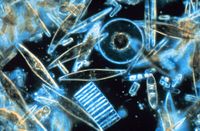
Photo from wikipedia
Elemental analysis of rare earth elements is essential in a variety of fields including environmental monitoring and nuclear safeguards; however, current techniques are often labor intensive, time consuming, and/or costly… Click to show full abstract
Elemental analysis of rare earth elements is essential in a variety of fields including environmental monitoring and nuclear safeguards; however, current techniques are often labor intensive, time consuming, and/or costly to perform. The difficulty arises in preparing samples, which requires separating the chemically and physically similar lanthanides. However, by transitioning these separations to the microscale, the speed, cost, and simplicity of sample preparation can be drastically improved. Here, all fourteen non‐radioactive lanthanides (lanthanum through lutetium minus promethium) are separated by ITP for the first time in a serpentine fused‐silica microchannel (70 µm wide × 70 µm tall × 33 cm long) in <10 min at voltages ≤8 kV with limits of detection on the order of picomoles. This time includes the 2 min electrokinetic injection time at 2 kV to load sample into the microchannel. The final leading electrolyte consisted of 10 mM ammonium acetate, 7 mM α‐hydroxyisobutyric acid, 1% polyvinylpyrrolidone, and the final terminating electrolyte consisted of 10 mM acetic acid, 7 mM α‐hydroxyisobutyric acid, and 1% polyvinylpyrrolidone. Electrophoretic electrodes are embedded in the microchip reservoirs so that voltages can be quickly applied and switched during operation. The limits of detection are quantified using a commercial capacitively coupled contactless conductivity detector (C4D) to calculate ITP zone lengths in combination with ITP theory. Optimization of experimental procedures and reproducibility based on statistical analysis of subsequent experimental results are addressed. Percent error values in band length and conductivity are ≤8.1 and 0.37%, respectively.
Journal Title: ELECTROPHORESIS
Year Published: 2019
Link to full text (if available)
Share on Social Media: Sign Up to like & get
recommendations!